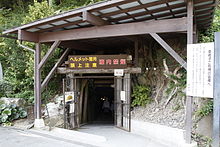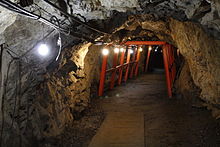- Matsushiro Underground Imperial Headquarters
-
Coordinates: 36°32′45″N 138°12′14″E / 36.545811°N 138.203931°E
The Matsushiro Underground Imperial Headquarters (松代大本営跡 Matsushiro Daihon'ei Ato, lit. Matsushiro Imperial Headquarters Site) was a large underground bunker complex built during the Second World War in the Matsushiro suburb of Nagano, Japan.[1]. The facility was to be used by Emperor Hirohito, his family, and the Imperial General Headquarters to direct Japanese armed forces fighting against the Allied invasion of Japan.
Parts of the caves are open to the public today, and are operated as a tourist attraction by Nagano.
Contents
Construction
Construction began on November 11, 1944[2] and continued until Japan's surrender on August 15, 1945. Construction was 75% completed at the end of the war, with 5,856.6 square meters (63,040 sq ft) of floor-space (59,635 cubic meters (2,106,000 cu ft) of volume) excavated. Between 7,000 and 10,000 Korean slave laborers were used to build the complex, and it is estimated that 1,500 of them died.[3] Forty-six Koreans disappeared on August 15, 1945, when Japan surrendered. The project cost ¥200,000,000.[2]
Composition
The complex was an interlinked series of tunnels underneath several mountains. Facilities for the Imperial General Headquarters and palace functions were constructed under Mount Maizuru; military communications under Mount Saijo; NHK and central telephone facilities under Mount Zōzan; and the Imperial Sanctuary under Mount Kobo.[4]
Purpose
The original purpose of the complex was to serve as an alternative headquarters for the Imperial General headquarters. However, in March 1945, secret orders were issued to add a palace to the complex.[5] Yoshijirō Umezu informed Emperor Hirohito about construction of the complex in May, but did not tell him that it contained a palace. The plan was to relocate the Emperor to the complex in an armored train. When informed about the existence of the palace in July, Hirohito twice refused to relocate.[5] It has been suggested that he refused because going to Matsushiro would have effectively isolated the Emperor and allowed the Army to rule in his name, effectively guaranteeing they would pursue the war to "suicidal extremes".[6]
The complex was designed specifically to withstand B-29 bombings.[4]
Matsushiro today
After the surrender of Japan, most of the documentation relating to the Matsushiro complex was destroyed. As a result, very little is known about the day-to-day construction of the facility.[4]
The complex today is administered by Nagano city's sightseeing bureau. The caves are mostly closed to the public - only the first 500 meters of the Mount Zōzan facilities are open.[7]
The city of Nagano spent many years trying to attract the Olympic games, culminating in their successful bid to host the 1998 Winter Olympics. During the bidding period and again during the games itself, peace activists accused the city of Nagano and the Nagano Organizing Committee (NAOC) of burying the past. Yamane Masako noted that "just the other day, the authorities blocked the entrances to the underground shelters with fences, despite requests that the last Imperial General Headquarters should be preserved and left be open to the public. They're afraid it will hurt their chances to get an Olympic Games to come to Nagano. They're trying to draw down a curtain around the Showa era. It's inexcusable."
During the games, the complex was omitted from all maps and tourist information passed out to visitors. Peace activists asked the NAOC to include the caves on the list of interesting places to visit in Nagano, but their requests went unanswered.[8]
See also
Other bunkers:
- Project Greek Island (at The Greenbrier Hotel)
- Wolfsschanze
- Führerbunker
- Cabinet War Rooms
- Underground Project 131
Notes
- ^ McCormack, 253
- ^ a b Cook, 433
- ^ Cook, 436
- ^ a b c WWII Imperial Headquarters - Matsushiro . Japan Travel Guide. The Yamasa Institute
- ^ a b Drea, 206
- ^ Drea, 206-207
- ^ Japan Visitor Blog - Matsushiro Daihonei Nagano. JapanVisitor.com/Soccerphile. September 02, 2008
- ^ Digging Up the Past. Sonni Efron. Los Angeles Times, February 09, 1998
References
- Cook, Haruko Taya; Theodore F. Cook (1992). "Chapter 22 - Interview with Yamane Masako". Japan at War: An Oral History. New Press. ISBN 1565840399.
- Drea, Edward J. (2003). In the Service of the Emperor: Essays on the Imperial Japanese Army. University of Nebraska Press. ISBN 0803266383.
- McCormack, Gavan (2001). The Emptiness of Japanese Affluence. M.E. Sharpe. ISBN 0765607670.
Categories:- Bunkers
- Buildings and structures in Japan
- Military history of Japan during World War II
- Japanese home islands campaign
- Nagano Prefecture
Wikimedia Foundation. 2010.



